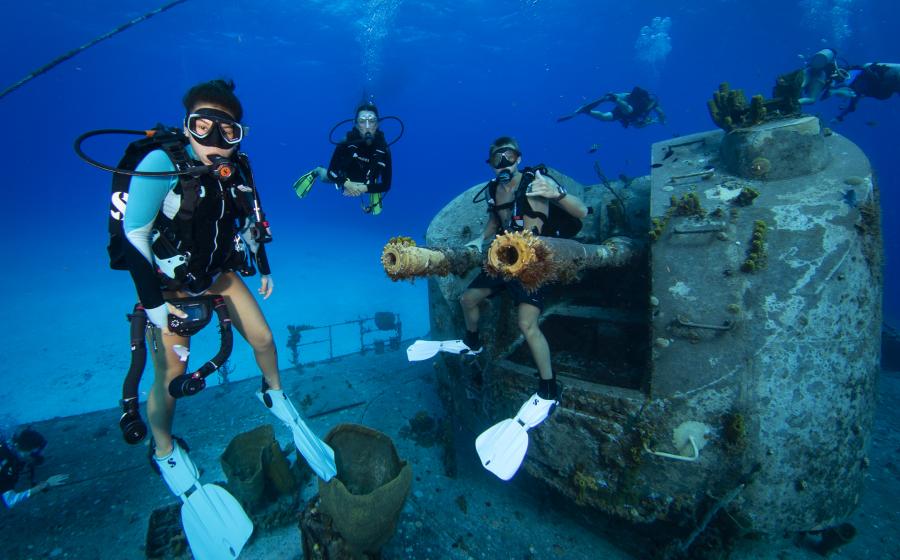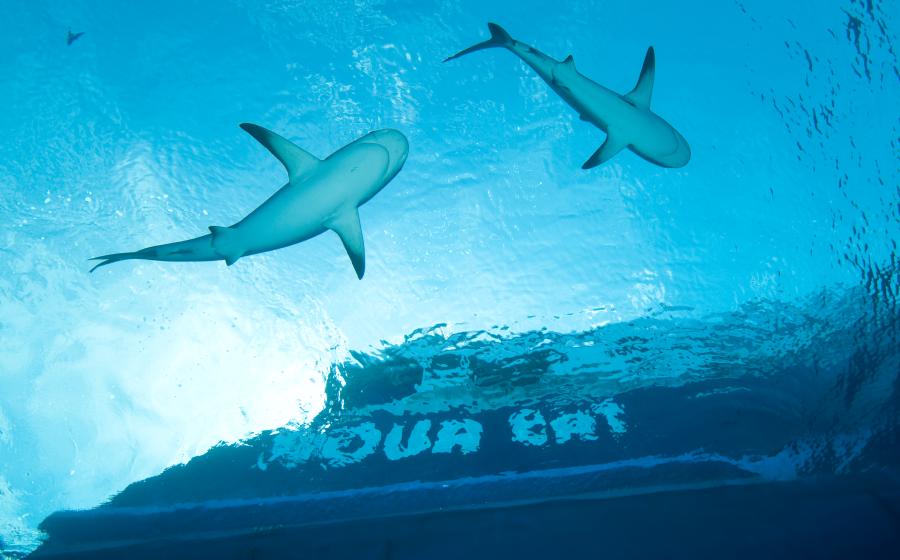My Camera Flooded--Now What?
||
|---|
|  |
|
| A clean, dry, well-lit workspace like this camera table on the Sun Dancer II is ideal for pre-dive camera maintenance.|
|  |
|
| A freshwater immersion in a commodious dip tank is the best defense against the hazards of salt water. Fresh water displaces the salt water relatively easily if the immersion happens immediately after the dive.|
|  |
|
| There are probably more than 500 O-rings in all the cameras on this table. Each one has the potential to cause a flood unless properly maintained.|
|  |
|
| A light coating of the appropriate grease is the first best step in keeping your O-rings happy and healthy.|
I flooded my first camera back in '79, my initial encounter with the awful truth about underwater photography equipment: If you take cameras in the water often enough, sooner or later, water will end up on the wrong side of the O-ring.
Since that time I've flooded plenty of underwater cameras and housings. Most floods were my fault and could have been avoided, but sometimes floods--like DCS--just happen. Here are my tips for avoiding it when you can and taking care of it when you can't.
Flood Avoidance: Love Thy O-Rings
An O-ring is the magical device that keeps water on the outside. Helping O-rings do their magic involves seven basic procedures:
-
Clean 'Em. The O-ring should be cleaned of grit, lint, hair and detritus each time the camera door is opened or lens changed. Make sure the O-ring channel on the camera or housing is also clean.
-
Grease 'Em. Use only a very light coating of the appropriate O-ring grease. Put a dab on your finger and run the O-ring through. Don't put the O-ring in the groove and smear grease over it. Grease does not make the seal, it only minimizes friction when the O-ring is moved into place.
-
Inspect 'Em. Even a tiny hair left on the O-ring can disrupt the seal under pressure and cause a flood. Service your O-rings in good light and a clean environment, and wear magnification glasses if necessary.
-
Change 'Em. Change O-rings before they go flat. O-rings compress and fatigue over time. At a certain point they won't be round anymore, and a flood is almost inevitable. The feel of a deformed O-ring is pretty obvious just by running it through your fingers, but small O-rings, like those on a battery compartment or strobe sync cord, are more difficult to diagnose. Change the user-replaceable O-rings at least once a year as cheap anti-flood insurance. For internal O-rings, professional maintenance service is neccessary. Depending on how frequently you use your cameras, visit a repair shop every year or two for replacement of internal O-rings.
Flood Avoidance: Bathe Thy Camera
If we used our cameras only in fresh water, maintenance probably would be much simpler. But we go into the ocean. Minerals and salts from seawater are left behind once the water evaporates. This grit finds its way into tiny orifices and can also disrupt the seal. That's why you should insist on a freshwater rinse bucket on every dive boat--and learn to use it properly:
-
Rinse It. Put your cameras and strobes in fresh water immediately to displace the salt water. Operate the knobs, buttons and controls while it's immersed in fresh water.
-
Remove It. Don't leave your camera in a crowded tank. Other divers may pile their cameras on top of yours. Sync cords can wrap around lenses or extension tubes; then, if careless divers pull their cameras out, yours could flood in the rinse tank. Dome ports are especially vulnerable in this environment and can easily be scratched by contact with other equipment.
-
Dry It. When changing film between dives, dry yourself and your camera before opening the back of the amphibious camera or housing. Work away from other divers who might be dripping, and open the camera back upside-down so that any errant water droplets will fall away rather than inside.
Flood Diagnosis
A flood can happen even when you do everything right. The trick is to recognize it immediately and take immediate appropriate action. Your camera may be flooded if:
-
bubbles stream from camera back
-
strobe fires spontaneously
-
strobe doesn't fire at all
-
condensation collects in viewfinder or film counter window
-
difficulty occurs in advancing film
Flood First Aid The First Steps
||
|---|
|  |
|
| You'll probably see this depressing sight eventually. It could be a housing or an amphibious camera, but mistakes happen and cameras get wet.|
|  |
|
| In preparation for repair, use a small Phillips head screwdriver to remove the four screws on the cover to the electronics panel.|
|  |
|
| Remove the cover and expose electronics module.|
|  |
|
| Insert garden hose into battery compartment and use sufficient water pressure to flush water through the camera.|
|  |
|
| A moisture alarm (note the two tiny prongs at the bottom of the housing) can help minimize flood damage. The best moisture alarms will have visible LEDs in the viewfinder, as well as an audible buzzer.|
|  |
|
| A housing will typically have a space at the bottom so that small bits of water don't hit the delicate camera inside. If you suspect a flood, keep the housing absolutely upright until you can open the back and dry the inside of the housing. Tipping it dow|
Since you could be several days from the nearest professional repair facility, what do you do about it? If it is a flooded Nikonos V, you'll probably wish you had brought along a copy of The Traveler's Guide to ER (Emergency Repair) for the Nikonos V Camera by Mike Haber and Mike Mesgleski. This handy little booklet provides step-by-step illustrated hints on how to get your wet camera operational again. Here are their suggestions for immediate first aid:
-
Turn off power by setting the camera to R, B or M.
-
Turn off strobe.
-
Keep camera upright and tilted slightly back to keep water in a single, reasonably non-damaging area.
-
Rinse camera before opening back or removing strobe cords.
-
Remove film. The authors say "rewinding wet film may drag water across your shutter blades which may not yet have been affected. Open the camera and remove the film without rewinding."
But you have a choice: Wet E-6 slide film can be processed. If you get it into the lab before it dries out, it can be rinsed and run like any other film. But, if you open the camera and expose the film to light, it will be destroyed. You'll have to be the judge of how important the latent images might be. If it's a highly productive roll, rewind and take your chances.
- Remove strobe cord and lens and examine closely for water damage. If the camera body floods, it is possible the lens did too, and maybe the water inside isn't obviously visible. It would be a shame to do thorough first aid on a flooded camera, get everything back in order, and then have water that is trapped in the lens seep back inside the camera body.
Flood First Aid: Major and Minor Surgery
With a very minor flood, the best move may be to dab out the droplets and keep working. However, if significant water intruded, and particularly if you see water on the shutter blades, major surgery is recommended, beginning with some level of disassembly and a freshwater rinse.
Here's what I do with a flooded amphibious camera. Locate a Phillips head screwdriver, a garden hose and fresh water, and a hair dryer:
-
Remove battery, film, lens and sync cord. Leave all ports open.
-
Open camera back.
-
Use small Phillips head screwdriver to remove four screws on inspection plate over the electronics module.
-
Prop pressure plate open by slipping it under the film advance lever.
-
Take a small garden hose (hose only, brass fitting cut off) and insert it into the battery port. Ideally, the hose diameter will nearly match that of the battery compartment. You may wish to carry a short length of this kind of hose in your travel kit.
-
Hold camera upright and use sufficient water pressure to flush fresh water up and over the electronics module. You'll begin to see water gently pouring over the shutter blades and over the electronics, but the fresh water won't go into the viewfinder (something to avoid at all costs, and the reason I don't completely immerse the camera in fresh water).
-
Dry camera thoroughly by setting it inside a cardboard box, with back door open, and gently drying with a hair dryer.
-
Reinsert battery and test automatic (TTL) functions. Maybe everything will work again, but at least you'll probably have the mechanical functions back so you can shoot on manual.
-
Send to a camera repair center for full service when you get home. Internal O-rings will definitely need relubrication.
This is not to imply only amphibious cameras flood. Actually, they are pretty rugged. It's just that there are more of them out there than any other underwater camera. Housed cameras can flood just as easily due to improper O-ring maintenance or operator error.
Bad news: If you get most modern housed electronic cameras wet, there is no means of economical repair, and you definitely won't get them operational in the field.
Good news: There is a fair bit of space inside the housing, so a little water intrusion may never hit the camera at all. With a moisture alarm properly installed, housed cameras are safe from minor floods.
Contact Stephen Frink: e-mail: [email protected], post: Frink Photo, PO Box 2720, Key Largo, FL 33037.
 A clean, dry, well-lit workspace like this camera table on the Sun Dancer II is ideal for pre-dive camera maintenance.
A clean, dry, well-lit workspace like this camera table on the Sun Dancer II is ideal for pre-dive camera maintenance.
 A freshwater immersion in a commodious dip tank is the best defense against the hazards of salt water. Fresh water displaces the salt water relatively easily if the immersion happens immediately after the dive.
A freshwater immersion in a commodious dip tank is the best defense against the hazards of salt water. Fresh water displaces the salt water relatively easily if the immersion happens immediately after the dive.
 There are probably more than 500 O-rings in all the cameras on this table. Each one has the potential to cause a flood unless properly maintained.
There are probably more than 500 O-rings in all the cameras on this table. Each one has the potential to cause a flood unless properly maintained.
 A light coating of the appropriate grease is the first best step in keeping your O-rings happy and healthy.
flooded my first camera back in '79, my initial encounter with the awful truth about underwater photography equipment: If you take cameras in the water often enough, sooner or later, water will end up on the wrong side of the O-ring.
A light coating of the appropriate grease is the first best step in keeping your O-rings happy and healthy.
flooded my first camera back in '79, my initial encounter with the awful truth about underwater photography equipment: If you take cameras in the water often enough, sooner or later, water will end up on the wrong side of the O-ring.
Since that time I've flooded plenty of underwater cameras and housings. Most floods were my fault and could have been avoided, but sometimes floods--like DCS--just happen. Here are my tips for avoiding it when you can and taking care of it when you can't.
Flood Avoidance: Love Thy O-Rings
An O-ring is the magical device that keeps water on the outside. Helping O-rings do their magic involves seven basic procedures:
Clean 'Em. The O-ring should be cleaned of grit, lint, hair and detritus each time the camera door is opened or lens changed. Make sure the O-ring channel on the camera or housing is also clean.
Grease 'Em. Use only a very light coating of the appropriate O-ring grease. Put a dab on your finger and run the O-ring through. Don't put the O-ring in the groove and smear grease over it. Grease does not make the seal, it only minimizes friction when the O-ring is moved into place.
Inspect 'Em. Even a tiny hair left on the O-ring can disrupt the seal under pressure and cause a flood. Service your O-rings in good light and a clean environment, and wear magnification glasses if necessary.
Change 'Em. Change O-rings before they go flat. O-rings compress and fatigue over time. At a certain point they won't be round anymore, and a flood is almost inevitable. The feel of a deformed O-ring is pretty obvious just by running it through your fingers, but small O-rings, like those on a battery compartment or strobe sync cord, are more difficult to diagnose. Change the user-replaceable O-rings at least once a year as cheap anti-flood insurance. For internal O-rings, professional maintenance service is neccessary. Depending on how frequently you use your cameras, visit a repair shop every year or two for replacement of internal O-rings.
Flood Avoidance: Bathe Thy Camera
If we used our cameras only in fresh water, maintenance probably would be much simpler. But we go into the ocean. Minerals and salts from seawater are left behind once the water evaporates. This grit finds its way into tiny orifices and can also disrupt the seal. That's why you should insist on a freshwater rinse bucket on every dive boat--and learn to use it properly:
Rinse It. Put your cameras and strobes in fresh water immediately to displace the salt water. Operate the knobs, buttons and controls while it's immersed in fresh water.
Remove It. Don't leave your camera in a crowded tank. Other divers may pile their cameras on top of yours. Sync cords can wrap around lenses or extension tubes; then, if careless divers pull their cameras out, yours could flood in the rinse tank. Dome ports are especially vulnerable in this environment and can easily be scratched by contact with other equipment.
Dry It. When changing film between dives, dry yourself and your camera before opening the back of the amphibious camera or housing. Work away from other divers who might be dripping, and open the camera back upside-down so that any errant water droplets will fall away rather than inside.
Flood Diagnosis
A flood can happen even when you do everything right. The trick is to recognize it immediately and take immediate appropriate action. Your camera may be flooded if:
bubbles stream from camera back
strobe fires spontaneously
strobe doesn't fire at all
condensation collects in viewfinder or film counter window
difficulty occurs in advancing film
Flood First Aid The First Steps
 You'll probably see this depressing sight eventually. It could be a housing or an amphibious camera, but mistakes happen and cameras get wet.
You'll probably see this depressing sight eventually. It could be a housing or an amphibious camera, but mistakes happen and cameras get wet.
 In preparation for repair, use a small Phillips head screwdriver to remove the four screws on the cover to the electronics panel.
In preparation for repair, use a small Phillips head screwdriver to remove the four screws on the cover to the electronics panel.
 Remove the cover and expose electronics module.
Remove the cover and expose electronics module.
 Insert garden hose into battery compartment and use sufficient water pressure to flush water through the camera.|
Insert garden hose into battery compartment and use sufficient water pressure to flush water through the camera.|
 A moisture alarm (note the two tiny prongs at the bottom of the housing) can help minimize flood damage. The best moisture alarms will have visible LEDs in the viewfinder, as well as an audible buzzer.
A moisture alarm (note the two tiny prongs at the bottom of the housing) can help minimize flood damage. The best moisture alarms will have visible LEDs in the viewfinder, as well as an audible buzzer.
 A housing will typically have a space at the bottom so that small bits of water don't hit the delicate camera inside. If you suspect a flood, keep the housing absolutely upright until you can open the back and dry the inside of the housing. Tipping it dow|
Since you could be several days from the nearest professional repair facility, what do you do about it? If it is a flooded Nikonos V, you'll probably wish you had brought along a copy of The Traveler's Guide to ER (Emergency Repair) for the Nikonos V Camera by Mike Haber and Mike Mesgleski. This handy little booklet provides step-by-step illustrated hints on how to get your wet camera operational again. Here are their suggestions for immediate first aid:
A housing will typically have a space at the bottom so that small bits of water don't hit the delicate camera inside. If you suspect a flood, keep the housing absolutely upright until you can open the back and dry the inside of the housing. Tipping it dow|
Since you could be several days from the nearest professional repair facility, what do you do about it? If it is a flooded Nikonos V, you'll probably wish you had brought along a copy of The Traveler's Guide to ER (Emergency Repair) for the Nikonos V Camera by Mike Haber and Mike Mesgleski. This handy little booklet provides step-by-step illustrated hints on how to get your wet camera operational again. Here are their suggestions for immediate first aid:
Turn off power by setting the camera to R, B or M.
Turn off strobe.
Keep camera upright and tilted slightly back to keep water in a single, reasonably non-damaging area.
Rinse camera before opening back or removing strobe cords.
Remove film. The authors say "rewinding wet film may drag water across your shutter blades which may not yet have been affected. Open the camera and remove the film without rewinding."
But you have a choice: Wet E-6 slide film can be processed. If you get it into the lab before it dries out, it can be rinsed and run like any other film. But, if you open the camera and expose the film to light, it will be destroyed. You'll have to be the judge of how important the latent images might be. If it's a highly productive roll, rewind and take your chances.
- Remove strobe cord and lens and examine closely for water damage. If the camera body floods, it is possible the lens did too, and maybe the water inside isn't obviously visible. It would be a shame to do thorough first aid on a flooded camera, get everything back in order, and then have water that is trapped in the lens seep back inside the camera body.
Flood First Aid: Major and Minor Surgery
With a very minor flood, the best move may be to dab out the droplets and keep working. However, if significant water intruded, and particularly if you see water on the shutter blades, major surgery is recommended, beginning with some level of disassembly and a freshwater rinse.
Here's what I do with a flooded amphibious camera. Locate a Phillips head screwdriver, a garden hose and fresh water, and a hair dryer:
Remove battery, film, lens and sync cord. Leave all ports open.
Open camera back.
Use small Phillips head screwdriver to remove four screws on inspection plate over the electronics module.
Prop pressure plate open by slipping it under the film advance lever.
Take a small garden hose (hose only, brass fitting cut off) and insert it into the battery port. Ideally, the hose diameter will nearly match that of the battery compartment. You may wish to carry a short length of this kind of hose in your travel kit.
Hold camera upright and use sufficient water pressure to flush fresh water up and over the electronics module. You'll begin to see water gently pouring over the shutter blades and over the electronics, but the fresh water won't go into the viewfinder (something to avoid at all costs, and the reason I don't completely immerse the camera in fresh water).
Dry camera thoroughly by setting it inside a cardboard box, with back door open, and gently drying with a hair dryer.
Reinsert battery and test automatic (TTL) functions. Maybe everything will work again, but at least you'll probably have the mechanical functions back so you can shoot on manual.
Send to a camera repair center for full service when you get home. Internal O-rings will definitely need relubrication.
This is not to imply only amphibious cameras flood. Actually, they are pretty rugged. It's just that there are more of them out there than any other underwater camera. Housed cameras can flood just as easily due to improper O-ring maintenance or operator error.
Bad news: If you get most modern housed electronic cameras wet, there is no means of economical repair, and you definitely won't get them operational in the field.
Good news: There is a fair bit of space inside the housing, so a little water intrusion may never hit the camera at all. With a moisture alarm properly installed, housed cameras are safe from minor floods.
Contact Stephen Frink: e-mail: [email protected], post: Frink Photo, PO Box 2720, Key Largo, FL 33037.






